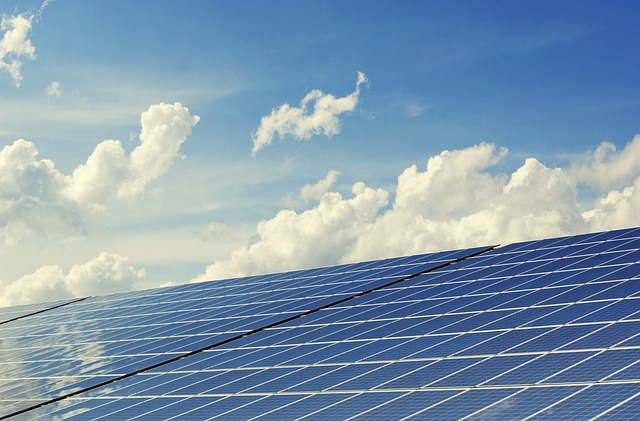“Maximize Sunlight, Maximize Savings: Solar Trackers Boost Efficiency for a Brighter Tomorrow.”
Solar trackers are innovative devices that enhance the efficiency of solar energy systems by adjusting the orientation of solar panels throughout the day to follow the sun’s path. By maintaining an optimal angle relative to the sun, solar trackers maximize the amount of sunlight captured, leading to increased energy production compared to fixed solar installations. This technology not only improves the overall performance of solar systems but also contributes to a more sustainable energy future by optimizing the use of renewable resources. As the demand for clean energy continues to rise, the integration of solar trackers into solar power systems represents a significant advancement in harnessing solar energy more effectively.
Increased Energy Capture
Solar energy has emerged as a pivotal solution in the quest for sustainable and renewable energy sources. As technology advances, the efficiency of solar systems continues to improve, and one of the most significant innovations in this field is the solar tracker. By adjusting the position of solar panels throughout the day, solar trackers enhance energy capture, leading to a more effective harnessing of sunlight. This increased energy capture is crucial for maximizing the output of solar installations, whether they are residential, commercial, or utility-scale.
To understand how solar trackers contribute to increased energy capture, it is essential to recognize the fundamental principle of solar energy generation. Solar panels convert sunlight into electricity, but their efficiency is highly dependent on the angle at which sunlight strikes the panels. When panels are fixed in a stationary position, they can only capture sunlight effectively during certain times of the day. As the sun moves across the sky, the angle of incidence changes, resulting in a decrease in energy absorption. This is where solar trackers come into play. By continuously adjusting the orientation of the panels to follow the sun’s trajectory, solar trackers ensure that the panels are always positioned at the optimal angle for maximum sunlight exposure.
Research has shown that solar trackers can increase energy capture by 20% to 50% compared to fixed solar systems. This significant boost in energy production is particularly beneficial in regions with high solar irradiance, where the sun shines brightly for extended periods. Moreover, the increased energy capture translates into higher electricity generation, which can lead to improved return on investment for solar system owners. As energy prices fluctuate and the demand for renewable energy rises, the ability to generate more electricity from the same number of panels becomes increasingly valuable.
In addition to enhancing energy capture, solar trackers also contribute to the overall efficiency of solar systems by reducing the amount of land required for solar installations. With fixed systems, more panels are needed to achieve the same energy output as a tracker system. By maximizing energy capture, solar trackers allow for a more compact arrangement of solar panels, which can be particularly advantageous in areas where land is limited or expensive. This efficient use of space not only lowers installation costs but also minimizes the environmental impact of solar projects.
Furthermore, the integration of solar trackers with advanced monitoring and control systems enhances their performance. These systems can analyze weather patterns, solar irradiance levels, and other environmental factors to optimize the tracking algorithms. As a result, solar trackers can adjust their positioning in real-time, ensuring that they are always aligned with the sun, even in changing weather conditions. This adaptability further increases energy capture and contributes to the overall reliability of solar energy systems.
In conclusion, solar trackers represent a significant advancement in solar technology, offering a compelling solution for increasing energy capture. By ensuring that solar panels are always oriented for optimal sunlight exposure, these devices enhance the efficiency of solar systems, leading to greater electricity generation and improved economic returns. As the demand for renewable energy continues to grow, the role of solar trackers in maximizing energy capture will undoubtedly become more critical, paving the way for a more sustainable energy future. With their ability to adapt to changing conditions and optimize performance, solar trackers are not just an enhancement; they are a vital component of modern solar energy systems.
Enhanced Performance in Low Light

Solar energy has emerged as a pivotal solution in the quest for sustainable energy sources, and the efficiency of solar systems plays a crucial role in maximizing their potential. One of the most significant advancements in solar technology is the development of solar trackers, which are designed to enhance the performance of solar panels, particularly in low-light conditions. Understanding how solar trackers operate and their impact on energy production can illuminate their importance in the renewable energy landscape.
Solar trackers are devices that adjust the orientation of solar panels throughout the day, ensuring that they are always positioned to capture the maximum amount of sunlight. This dynamic adjustment is particularly beneficial during the early morning and late afternoon when the sun is lower in the sky. However, their advantages extend beyond just optimizing exposure to direct sunlight. In low-light conditions, such as overcast days or during the winter months, solar trackers can significantly improve energy capture by allowing panels to maintain an optimal angle relative to the sun’s position.
When sunlight is diffuse, as it often is on cloudy days, the angle at which light strikes the solar panels becomes even more critical. Fixed solar panels may not be able to harness this scattered light effectively, leading to a drop in energy production. In contrast, solar trackers can pivot and tilt to align with the sun’s rays, even when they are not direct. This capability allows solar systems equipped with trackers to generate more electricity under less-than-ideal conditions, thereby enhancing overall performance.
Moreover, the efficiency of solar trackers in low-light scenarios is not merely a matter of increased energy capture; it also translates into improved reliability and consistency of energy output. For instance, in regions where weather patterns frequently shift, the ability to adapt to changing light conditions can help stabilize energy production. This is particularly important for grid integration, where a steady supply of energy is essential for meeting demand. By ensuring that solar panels are always positioned to optimize light absorption, solar trackers contribute to a more reliable energy source, which is crucial for both residential and commercial applications.
In addition to their operational benefits, solar trackers also play a role in the economic viability of solar energy systems. By increasing energy production, they can enhance the return on investment for solar installations. This is especially relevant in areas where land use is a consideration; maximizing energy output from a given area can make solar projects more attractive to investors and developers. Consequently, the integration of solar trackers can lead to a more favorable economic landscape for renewable energy projects, encouraging further adoption of solar technology.
Furthermore, as technology continues to advance, the efficiency of solar trackers is expected to improve, making them even more effective in low-light conditions. Innovations in sensor technology and control systems are paving the way for smarter trackers that can respond more quickly and accurately to changes in light conditions. This ongoing evolution will likely enhance the performance of solar systems even further, solidifying the role of solar trackers as a vital component in the renewable energy sector.
In conclusion, solar trackers significantly enhance the performance of solar systems, particularly in low-light conditions. By optimizing the angle of solar panels to capture diffuse sunlight, they improve energy production, reliability, and economic viability. As the technology continues to evolve, the benefits of solar trackers will only become more pronounced, reinforcing their importance in the transition to a sustainable energy future.
Improved System Longevity
Solar energy has emerged as a pivotal solution in the quest for sustainable and renewable energy sources. As the technology surrounding solar systems continues to evolve, one of the most significant advancements has been the development of solar trackers. These devices, designed to follow the sun’s trajectory throughout the day, not only enhance energy production but also contribute to the improved longevity of solar systems. Understanding how solar trackers achieve this can provide valuable insights for both current and prospective solar energy users.
To begin with, solar trackers optimize the angle at which solar panels receive sunlight. By adjusting their position in real-time, these trackers ensure that panels are always oriented towards the sun, maximizing exposure and, consequently, energy output. This increased efficiency translates into a more effective use of the solar panels, which can lead to a reduction in wear and tear. When solar panels are consistently positioned to capture the most sunlight, they operate at optimal levels, reducing the stress on their components. This is particularly important because solar panels are subjected to various environmental factors, including temperature fluctuations, wind, and precipitation. By minimizing the strain on these systems, solar trackers can significantly extend the lifespan of solar panels.
Moreover, the enhanced energy production facilitated by solar trackers can lead to a more balanced energy output over time. Traditional fixed solar systems may experience periods of underperformance, especially during early mornings or late afternoons when the sun is at a lower angle. This inconsistency can lead to fluctuations in energy generation, which may not only affect the efficiency of the system but also its overall reliability. In contrast, solar trackers provide a steady and reliable energy output throughout the day. This consistency not only enhances the performance of the solar system but also reduces the likelihood of operational issues that could arise from irregular energy production. As a result, the overall system experiences less stress, contributing to its longevity.
In addition to optimizing energy capture and reducing wear, solar trackers can also facilitate better maintenance practices. With their ability to adjust angles and positions, these systems can be designed to minimize the accumulation of dirt and debris on solar panels. Dust and grime can significantly hinder the efficiency of solar panels, leading to decreased energy output and potential damage over time. By keeping panels cleaner and more efficient, solar trackers help maintain optimal performance levels, which in turn supports the longevity of the entire solar system.
Furthermore, the integration of advanced technology in solar trackers allows for predictive maintenance. Many modern trackers are equipped with sensors and monitoring systems that can detect potential issues before they escalate into significant problems. This proactive approach to maintenance not only ensures that the system operates efficiently but also extends its operational life. By addressing minor issues early on, solar trackers help prevent costly repairs or replacements that could arise from neglecting maintenance.
In conclusion, the role of solar trackers in enhancing the efficiency and longevity of solar systems cannot be overstated. By optimizing energy capture, reducing wear and tear, facilitating better maintenance practices, and enabling predictive maintenance, these devices contribute significantly to the overall performance and lifespan of solar installations. As the demand for renewable energy continues to grow, understanding and implementing solar trackers will be essential for maximizing the benefits of solar technology, ensuring that it remains a viable and sustainable energy source for years to come.
Cost-Effectiveness Over Time
As the world increasingly turns to renewable energy sources, solar power has emerged as a leading contender in the quest for sustainable energy solutions. Among the various technologies that enhance solar energy systems, solar trackers stand out for their ability to significantly improve efficiency and, consequently, cost-effectiveness over time. By adjusting the orientation of solar panels to follow the sun’s trajectory throughout the day, solar trackers maximize the amount of sunlight captured, which translates directly into increased energy production. This enhanced efficiency not only boosts the overall output of solar systems but also contributes to a more favorable return on investment.
To understand the cost-effectiveness of solar trackers, it is essential to consider the initial investment versus long-term gains. While solar trackers typically require a higher upfront cost compared to fixed solar panel installations, the increased energy yield they provide can offset this initial expenditure. Studies have shown that solar trackers can increase energy production by 20% to 50%, depending on geographic location and weather conditions. This substantial increase in energy generation means that the payback period for the additional investment in solar trackers can be significantly reduced. As a result, the long-term financial benefits often outweigh the initial costs, making solar trackers a wise choice for both residential and commercial solar installations.
Moreover, the economic advantages of solar trackers extend beyond mere energy production. By generating more electricity, these systems can lead to lower utility bills and increased savings over time. For businesses, this can translate into reduced operational costs, allowing for reinvestment in other areas of the company. Additionally, the surplus energy produced can be sold back to the grid in many regions, creating an additional revenue stream. This aspect of solar trackers not only enhances their cost-effectiveness but also contributes to a more sustainable energy ecosystem by promoting the use of renewable resources.
Furthermore, as technology continues to advance, the costs associated with solar trackers are gradually decreasing. Innovations in materials and manufacturing processes have led to more affordable and efficient tracking systems. This trend is likely to continue, making solar trackers an increasingly attractive option for new solar installations. As the market for solar energy expands, economies of scale will further drive down costs, enhancing the overall feasibility of integrating solar trackers into solar systems.
In addition to financial considerations, the environmental impact of solar trackers cannot be overlooked. By maximizing energy production, these systems contribute to a greater reduction in greenhouse gas emissions. This aligns with global efforts to combat climate change and transition to cleaner energy sources. As more individuals and businesses recognize the importance of sustainability, the demand for efficient solar solutions like trackers is expected to rise, further solidifying their role in the renewable energy landscape.
In conclusion, the cost-effectiveness of solar trackers over time is a compelling argument for their adoption in solar energy systems. By increasing energy production, reducing payback periods, and providing additional revenue opportunities, solar trackers offer significant financial benefits that can outweigh their initial costs. As technology continues to evolve and the push for sustainable energy intensifies, solar trackers will likely play an increasingly vital role in enhancing the efficiency and viability of solar power, making them an essential consideration for anyone looking to invest in renewable energy solutions.
Q&A
1. **Question:** How do solar trackers increase energy capture?
**Answer:** Solar trackers adjust the position of solar panels throughout the day to follow the sun’s path, maximizing direct sunlight exposure and increasing energy capture by up to 25-35%.
2. **Question:** What types of solar trackers are commonly used?
**Answer:** The two main types of solar trackers are single-axis trackers, which rotate on one axis, and dual-axis trackers, which can move on both horizontal and vertical axes for optimal sun alignment.
3. **Question:** How do solar trackers impact the overall efficiency of solar systems?
**Answer:** By maintaining optimal alignment with the sun, solar trackers enhance the overall efficiency of solar systems, leading to higher energy output and improved return on investment.
4. **Question:** Are there any drawbacks to using solar trackers?
**Answer:** Yes, solar trackers can be more expensive to install and maintain compared to fixed solar systems, and they may require more land area and structural support.
Conclusion
Solar trackers enhance the efficiency of solar systems by adjusting the orientation of solar panels throughout the day to follow the sun’s path. This maximizes sunlight exposure, leading to increased energy production compared to fixed systems. By optimizing the angle of incidence, solar trackers can improve energy capture by 20-50%, making solar installations more productive and cost-effective over time. Consequently, the integration of solar trackers is a significant advancement in solar technology, contributing to greater overall efficiency and sustainability in solar energy generation.



